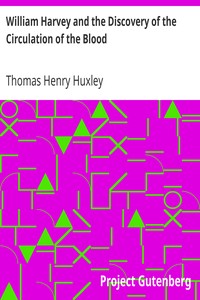| Author |
Huxley, Thomas Henry, 1825-1895 |
| Title |
William Harvey and the Discovery of the Circulation of the Blood
|
| Note |
Reading ease score: 50.2 (10th to 12th grade). Somewhat difficult to read.
|
| Credits |
Produced by Amy E. Zelmer, and David Widger
|
| Summary |
"William Harvey and the Discovery of the Circulation of the Blood" by Thomas H. Huxley is a scientific publication that examines the life and significant contributions of William Harvey, a prominent physician of the early 17th century. Written in the late 19th century, the book focuses on Harvey's groundbreaking discovery of the blood circulation system, a topic that revolutionized biological sciences and physiology. Huxley's intention is to highlight both Harvey's historical context and the lasting impact of his work. In the text, Huxley outlines Harvey's educational journey, tracing his growth from a student in Cambridge to a leading figure in London’s medical community, where he ultimately identifies the true course of blood flow through the body. He explains how, through careful observation and experimentation, Harvey determined that blood circulates in a continuous loop from the heart through the body and back again, opposing the prevailing beliefs of his time. Huxley emphasizes the scientific methodology behind Harvey's work and the importance of questioning established knowledge, presenting Harvey as not only a scientist but a pioneer of modern physiology whose findings have laid the foundation for contemporary medical understanding. (This is an automatically generated summary.)
|
| Language |
English |
| LoC Class |
QP: Science: Physiology
|
| Subject |
Harvey, William, 1578-1657
|
| Subject |
Blood -- Circulation -- History
|
| Category |
Text |
| EBook-No. |
2939 |
| Release Date |
Nov 1, 2001 |
| Most Recently Updated |
Oct 21, 2013 |
| Copyright Status |
Public domain in the USA. |
| Downloads |
188 downloads in the last 30 days. |
|
Project Gutenberg eBooks are always free!
|

